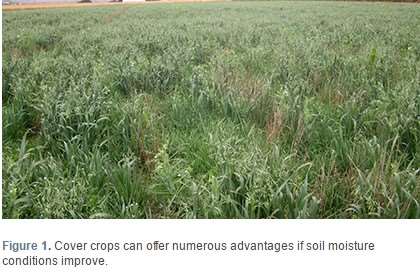By Ruth Beck
Hot, dry weather has seriously reduced grass production this spring across many areas of South Dakota. With the early onset of drought, many livestock producers are concerned about feed supplies. Annual forages may be an option for producers on unplanted fields with good moisture reserves or on failed fields when soil moisture levels improve.
The results from research evaluating warm and cool season forages in Western South Dakota during the years of 2008-10 may help with decisions if the weather pattern changes.
Warm-Season Forages
Potential warm-season forage options include sudangrass, forage sorghum, sorghum-sudan crosses, pearl and foxtail millets, and teffgrass. These crops are drought tolerant and germinate well when soil temperatures are warm. Therefore, they provide the best options for forage production during the warm summer months. Foxtail millets are shallow rooted and respond well to summer rains. They can provide a hay crop in a relatively short period of time but are not as well suited to grazing due to slow regrowth. Pearl millets can provide good quality pasture, hay and silage. This plant is leafy with a thick stem which may make it more difficult to cure as hay but it regrows well and therefore can provide good grazing. Sudangrass is another that can provide extra hay, silage or pasture, while forage sorghums are more suited for silage or green chop. The sorghum-sudangrass crosses can also provide some heat and drought tolerant feed. They can be grazed, or used for green chop, silage or hay. The brown mid rib types of warm season grasses are lower in lignin and more digestible. On average results indicated that teffgrass yielded less than other warm season grasses but feed value was better earlier in the season. Teffgrass can be grazed or hayed. However, grazing first growth can result in plants being pulled out by the roots. This would affect regrowth.
Care should be taken when grazing forage sorghums, sudangrass and sorghum-sudan crosses as they can develop elevated levels of prussic acid after drought or freeze injury. Prussic acid can be toxic to livestock.

Small Grains & Cool-Season Legumes
If soil moisture levels do not improve until later in the summer, it may be better for producers to consider small grains and/or cool season legumes. Small grains can provide excellent fall or early spring pasture. They are high in nutrients from early green up to jointing stage. It is recommended that cereal grains not be grazed until plants are 6-8 inches tall. Grass tetany can be a potential problem when grazing small grains too early.
Both winter and spring small grains can be used as hay. Oats have the advantage of not having awns which can affect palatability. Maturity at harvest can affect nutrient composition of different small grains with the nutrient composition of small grain forage declining with increasing maturity. Growing field peas in a mix with oats, barley or triticale will increase relative feed value of the small grain.
Cover Crop Mixtures
In recent years, many producers have been utilizing cover crops to produce extra forage. Mixes can be composed of warm season or cool season species depending on the timing of the seeding and when cover crop growth and forage production is desired. The NRCS has a Recommended Cover Crop Mixes spreadsheet tool that can help with cover crop decisions such as species choice, suggested mixes for different purposes and seeding rates.
Click here to see more...